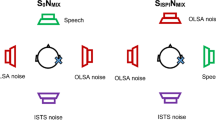Abstract
The aim of this study was to examine the functional hearing results regarding speech perception and auditory sound localization in a high-resolution directional hearing setup following implantation with a new bone conduction device (MED-EL Bonebridge, Innsbruck, Austria). In addition, we assessed the patient acceptance of the Bonebridge system using a questionnaire. The study design is retrospective study. The setting is University Hospital Frankfurt. 18 patients implanted with a Bonebridge device from May 2012 to January 2015 were participated in this study. Speech perception in quiet was tested with the Freiburg monosyllable test at a presentation level of 65 dB SPL. Speech perception in noise was tested post-operatively with the Oldenburg sentence test (OLSA) in best-aided condition. We assessed auditory sound localization with a high-resolution directional hearing setup. To evaluate the acceptance by patients using the Bonebridge in daily life, we used a modified questionnaire. The overall average of functional hearing gain (n = 18) was 29.3 dB (±20.7 dB). Speech perception of monosyllabic words in quiet improved by 20.7% on average, compared with the pre-operative aided condition. Mean speech reception thresholds (SRTs) of the Oldenburg sentence test (OLSA) improved significantly from −3.8 dB SNR (range −5.7 to 5.8 dB SNR) to −5.2 dB SNR (range −6.3 to −0.6 dB SNR) after implantation. Regarding localization abilities, no significant difference was found between the unaided and aided conditions following Bonebridge implantation. A survey of patients’ acceptance and handling of the Bonebridge implant in daily life revealed high patient satisfaction. All patients accepted and benefited from the implanted system. No infections or adverse surgical effects occurred. Speech perception significantly improved in quiet and in noise. No significant difference in sound localization was observed. Acceptance of the Bonebridge implant, tested with a modified questionnaire, was high.






Similar content being viewed by others
References
Mertens G, Desmet J, Snik AF, Van de Heyning P (2014) An experimental objective method to determine maximum output and dynamic range of an active bone conduction implant: the Bonebridge. Otol Neurotol 35(7):1126–1130. doi:10.1097/MAO.0000000000000347
Pai I, Kelleher C, Nunn T, Pathak N, Jindal M, O’Connor AF, Jiang D (2012) Outcome of bone-anchored hearing aids for single-sided deafness: a prospective study. Acta Otolaryngol 132(7):751–755. doi:10.3109/00016489.2012.655862
Hol MK, Bosman AJ, Snik AF, Mylanus EA, Cremers CW (2005) Bone-anchored hearing aids in unilateral inner ear deafness: an evaluation of audiometric and patient outcome measurements. Otol Neurotol 26(5):999–1006
Laske RD, Röösli C, Pfiffner F, Veraguth D, Huber AM (2015) Functional results and subjective benefit of a transcutaneous bone conduction device in patients with single-sided deafness. Otol Neurotol 36(7):1151–1156. doi:10.1097/MAO.0000000000000791
Hassepass F, Bulla S, Aschendorff A, Maier W, Traser L, Steinmetz C (2015) The bonebridge as a transcutaneous bone conduction hearing system: preliminary surgical and audiological results in children and adolescents. Eur Arch Otorhinolaryngol 272(9):2235–2241
Canis M, Ihler F, Blum J, Matthias C (2013) CT-assisted navigation for retrosigmoidal implantation of the Bonebridge. HNO 61:1038–1044
Manrique M, Sanhueza I, Manrique R, Abajo Jd (2014) A new bone conduction implant: surgical technique and results. Otol Neurotol 35(2):216–220
Kiringoda R, Lustig LR (2013) A meta-analysis of the complications associated with osseointegrated hearing aids. Otol Neurotol. 34(5):790–794. doi:10.1097/MAO.0b013e318291c651
Rahne T, Seiwerth I, Götze G, Heider C, Radetzki F, Herzog M, Plontke SK (2015) Functional results after Bonebridge implantation in adults and children with conductive and mixed hearing loss. Eur Arch Otorhinolaryngol 272(11):3263–3269
Kuehnel V, Kollmeier B, Wagener K (1999) Entwicklung und Evaluation eines Satztests für die deutsche Sprache I–III: Design, Optimierung und Evaluation des Oldenburger Satztests. ZfA 38(1–3):4–15, 44–56, 86–95
Hahlbrock K-H (1953) Über Sprachaudiometrie und neue Wörterteste. Archiv für Ohren-, Nasen- und Kehlkopfheilkunde 162:394–431
Seeber B (2003) Untersuchung der auditiven Lokalisation mit einer Lichtzeigermethode. Dissertation, Technische Universität München
Weissgerber T (2014) Evaluation eines neuen Verfahrens zur Bestimmung der Genauigkeit der akustischen Lokalisation mit Berücksichtigung der Vorne-Hinten-Vertauschung. 17. Jahrestagung der DGA, Oldenburg
Kompis M, Pfiffner F, Krebs M, Caversaccio MD (2011) Factors influencing the decision for Baha in unilateral deafness: the bern benefit in single- sided deafness questionnaire. Adv Otorhinolaryngol 71:103–111. doi:10.1159/000323591
Wazen JJ, Ghossaini SN, Spitzer JB, Kuller M (2005) Localization by unilateral BAHA users. Otolaryngol Head Neck Surg 132(6):928–932
Niparko JK, Cox KM, Lustig LR (2003) Comparison of the bone anchored hearing aid implantable hearing device with contralateral routing of offside signal amplification in the rehabilitation of unilateral deafness. Otology & neurotology. 24(1):73–78
Riss D, Arnoldner C, Baumgartner WD, Blineder M, Flak S, Bachner A, Gstoettner W, Hamzavi JS (2014) Indication Criteria and Outcomes With the Bonebridge Transcutaneous Bone-Conduction Implant. The Laryngoscope. 124(12):2802–2806
Huber AM, Sim JH, Xie YZ, Chatzimichalis M, Ullrich O, Röösli C (2013) The Bonebridge: preclinical evaluation of a new transcutaneously-activated bone anchored hearing device. Hear Res 301:93–99. doi:10.1016/j.heares.2013.02.003
Blauert J (1997) Spatial hearing: the psychophysics of human sound localization. MIT Press, Cambridge
Author information
Authors and Affiliations
Corresponding author
Ethics declarations
Conflict of interest
The authors declare that they all have no conflict of interest.
Funding
This study was not funded.
Ethical approval
All procedures performed in studies involving human participants were in accordance with the ethical standards of the institutional research committee and with the 1964 Helsinki Declaration and its later amendments or comparable ethical standards. This study was approved by the local ethics committee (approval number 94/15).
Informed consent
Informed consent was only obtained from all individual participants included in the study due to the questionnaire. Because of the retrospective design, a further informed consent was not necessary.
Rights and permissions
About this article
Cite this article
Weiss, R., Leinung, M., Baumann, U. et al. Improvement of speech perception in quiet and in noise without decreasing localization abilities with the bone conduction device Bonebridge. Eur Arch Otorhinolaryngol 274, 2107–2115 (2017). https://doi.org/10.1007/s00405-016-4434-2
Received:
Accepted:
Published:
Issue Date:
DOI: https://doi.org/10.1007/s00405-016-4434-2




